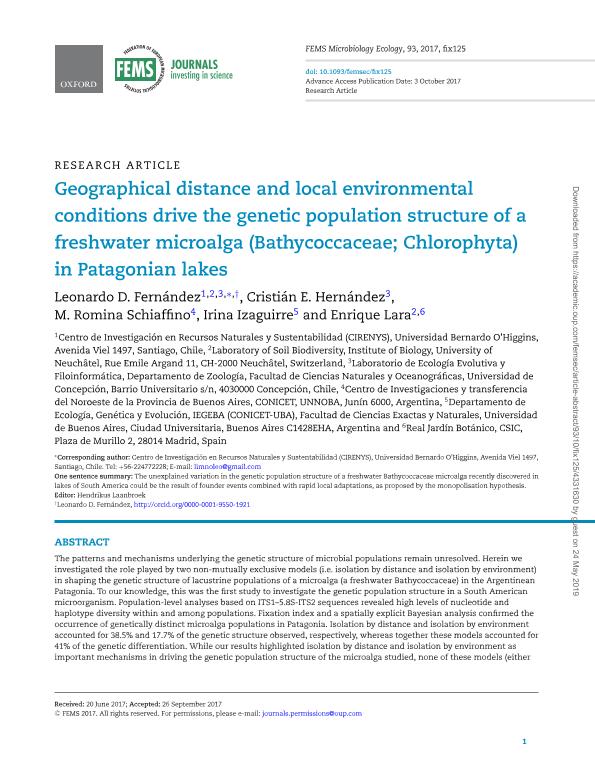Mostrar el registro sencillo del ítem
dc.contributor.author
Fernández, Leonardo D.
dc.contributor.author
Hernández, Cristián E.
dc.contributor.author
Schiaffino, María Romina

dc.contributor.author
Izaguirre, Irina

dc.contributor.author
Lara, Enrique
dc.date.available
2019-05-24T00:40:21Z
dc.date.issued
2017-10
dc.identifier.citation
Fernández, Leonardo D.; Hernández, Cristián E.; Schiaffino, María Romina; Izaguirre, Irina; Lara, Enrique; Geographical distance and local environmental conditions drive the genetic population structure of a freshwater microalga (Bathycoccaceae; Chlorophyta) in Patagonian lakes; Wiley Blackwell Publishing, Inc; Fems Microbiology Ecology; 93; 10; 10-2017; 1-10
dc.identifier.issn
0168-6496
dc.identifier.uri
http://hdl.handle.net/11336/77029
dc.description.abstract
The patterns and mechanisms underlying the genetic structure of microbial populations remain unresolved. Herein we investigated the role played by two non-mutually exclusive models (i.e. isolation by distance and isolation by environment) in shaping the genetic structure of lacustrine populations of a microalga (a freshwater Bathycoccaceae) in the Argentinean Patagonia. To our knowledge, this was the first study to investigate the genetic population structure in a South American microorganism. Population-level analyses based on ITS1-5.8S-ITS2 sequences revealed high levels of nucleotide and haplotype diversity within and among populations. Fixation index and a spatially explicit Bayesian analysis confirmed the occurrence of genetically distinct microalga populations in Patagonia. Isolation by distance and isolation by environment accounted for 38.5% and 17.7% of the genetic structure observed, respectively, whereas together these models accounted for 41% of the genetic differentiation. While our results highlighted isolation by distance and isolation by environment as important mechanisms in driving the genetic population structure of the microalga studied, none of these models (either alone or together) could explain the entire genetic differentiation observed. The unexplained variation in the genetic differentiation observed could be the result of founder events combined with rapid local adaptations, as proposed by the monopolisation hypothesis.
dc.format
application/pdf
dc.language.iso
eng
dc.publisher
Wiley Blackwell Publishing, Inc

dc.rights
info:eu-repo/semantics/openAccess
dc.rights.uri
https://creativecommons.org/licenses/by-nc-sa/2.5/ar/
dc.subject
Freshwater Protist
dc.subject
Gene Flow
dc.subject
Mamiellophyceae
dc.subject
Microbial Populations
dc.subject
Phytoplankton
dc.subject
Picoeukaryote
dc.subject.classification
Otras Ciencias Biológicas

dc.subject.classification
Ciencias Biológicas

dc.subject.classification
CIENCIAS NATURALES Y EXACTAS

dc.title
Geographical distance and local environmental conditions drive the genetic population structure of a freshwater microalga (Bathycoccaceae; Chlorophyta) in Patagonian lakes
dc.type
info:eu-repo/semantics/article
dc.type
info:ar-repo/semantics/artículo
dc.type
info:eu-repo/semantics/publishedVersion
dc.date.updated
2019-05-23T14:33:32Z
dc.identifier.eissn
1574-6941
dc.journal.volume
93
dc.journal.number
10
dc.journal.pagination
1-10
dc.journal.pais
Reino Unido

dc.journal.ciudad
Londres
dc.description.fil
Fil: Fernández, Leonardo D.. Universidad Bernardo O’Higgins; Chile. Universite de Neuchatel. Faculte de Sciences; Suiza. Universidad de Concepción. Facultad de Ciencias Naturales y Oceanografía. Departamento de Zoología; Chile
dc.description.fil
Fil: Hernández, Cristián E.. Universidad de Concepción. Facultad de Ciencias Naturales y Oceanografía. Departamento de Zoología; Chile
dc.description.fil
Fil: Schiaffino, María Romina. Consejo Nacional de Investigaciones Científicas y Técnicas. Centro de Investigaciones y Transferencia del Noroeste de la Provincia de Buenos Aires. Universidad Nacional del Noroeste de la Provincia de Buenos Aires. Centro de Investigaciones y Transferencia del Noroeste de la Provincia de Buenos Aires; Argentina
dc.description.fil
Fil: Izaguirre, Irina. Consejo Nacional de Investigaciones Científicas y Técnicas. Oficina de Coordinación Administrativa Ciudad Universitaria. Instituto de Ecología, Genética y Evolución de Buenos Aires. Universidad de Buenos Aires. Facultad de Ciencias Exactas y Naturales. Instituto de Ecología, Genética y Evolución de Buenos Aires; Argentina
dc.description.fil
Fil: Lara, Enrique. Universite de Neuchatel. Faculte de Sciences; Suiza
dc.journal.title
Fems Microbiology Ecology

dc.relation.alternativeid
info:eu-repo/semantics/altIdentifier/doi/http://dx.doi.org/10.1093/femsec/fix125
dc.relation.alternativeid
info:eu-repo/semantics/altIdentifier/url/https://academic.oup.com/femsec/article/93/10/fix125/4331630
Archivos asociados
